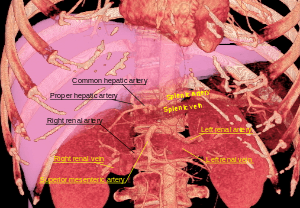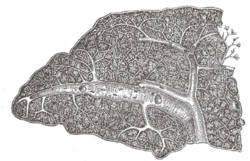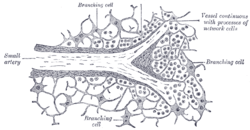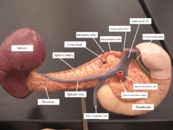Splenic artery
| Splenic artery | |
|---|---|
 The visceral surface of the spleen. | |
 Branches of the celiac artery. (Lienal artery is an old term for splenic artery, and is visible at center. The spleen is at center right. The stomach has been flipped out to reveal the splenic artery, so the greater curvature is at the top in this diagram.) | |
| Details | |
| Source | celiac artery |
| Branches |
Pancreatic branches Pancreatica magna Left gastro-omental Short gastric Trabecular arteries Posterior Gastric |
| Vein | splenic vein |
| Supplies | spleen |
| Identifiers | |
| Latin | arteria splenica, arteria lienalis |
| MeSH | A07.231.114.814 |
| TA | A12.2.12.040 |
| FMA | 14773 |
In anatomy, the splenic artery (in the past called the lienal artery) is the blood vessel that supplies oxygenated blood to the spleen. It branches from the celiac artery, and follows a course superior to the pancreas.
Structure
The splenic artery gives off branches to the stomach and pancreas before reaching the spleen.
| Branch | Description |
| branch to the pancreas | Multiple branches serving the pancreas. The largest is the arteria pancreatica magna |
| short gastric | upper part of greater curvature of the stomach and fundus of the stomach |
| left gastroepiploic | middle of greater curvature of the stomach |
| posterior gastric | posterior of stomach, gastric region superior to the splenic artery |
Note that the branches of the splenic artery do not reach all the way to the lower part of the greater curvature of the stomach. Instead, that region is supplied by the right gastroepiploic artery, a branch of the gastroduodenal artery. The two gastroepiploic arteries anastomose with each other at that point.
Relations
Along its course, it is accompanied by a similarly named vein, the splenic vein, which drains into the portal vein.
Clinical significance
Splenic artery aneurysms are rare, but still the third most common abdominal aneurysm, after aneurysms of the abdominal aorta and iliac arteries. They may occur in pregnant women in the third trimester and rupture carries a maternal mortality of greater than 50% and a fetal mortality of 70% - 90%. Risk factors include smoking and hypertension. For the treatment of patients who represent a high surgical risk, percutaneous endovascular treatment may be considered.
Additional images
 3D-rendered computed tomography, showing splenic artery at upper right.
3D-rendered computed tomography, showing splenic artery at upper right. The celiac artery and its branches.
The celiac artery and its branches. Transverse section of the human spleen, showing the distribution of the splenic artery and its branches.
Transverse section of the human spleen, showing the distribution of the splenic artery and its branches. Section of the spleen, showing the termination of the small bloodvessels.
Section of the spleen, showing the termination of the small bloodvessels. Posterior abdominal wall, after removal of the peritoneum, showing kidneys, suprarenal capsules, and great vessels.
Posterior abdominal wall, after removal of the peritoneum, showing kidneys, suprarenal capsules, and great vessels.
 Arteries and veins around the pancreas and spleen.
Arteries and veins around the pancreas and spleen.
References
- ^ Abbas MA, Stone WM, Fowl RJ, Gloviczki P, Oldenburg WA, Pairolero PC, Hallett JW, Bower TC, Panneton JM, Cherry KJ (2002)."Splenic arterya neurysms: two decades experience at Mayo clinic". Ann Vasc Surg. 16(4): 442-449. PMID 12089631
- ^ Jamsheer NS, Malik M (2001). "Ruptured splenic artery aneurysm". Ann Saudi Med. 21(5-6): pp. 340–341. Accessed July 30, 2005.
- ^ Pauletto R, Mieres J, Incarbone A, García A, Santaera O (2013). "Exclusión de aneurisma esplénico gigante con técnica de catéteres mother-in-child en paciente de alto riesgo quirúrgico". Revista Argentina de Cardioangiología Vol. 4(1): pp. 62–65, Buenos Aires (Argentina): Colegio Argentino de Cardioangiología Intervencionista. ISSN 2313-9307, retrieved 11 September 2013.
- ^ Suzuki K, Prates JC, DiDio LJ (1978)."Incidence and surgical importance of the posterior gastricartery", Ann. Surg. 187(2): 134-136.
- ^ Pauletto R, Mieres J, Incarbone A, García A, Santaera O (2013). "Exclusión de aneurisma esplénico gigante con técnica de catéteres mother-in-child en paciente de alto riesgo quirúrgico". Revista Argentina de Cardioangiología Vol. 4(1): pp. 62–65, Buenos Aires (Argentina): Colegio Argentino de Cardioangiología Intervencionista. ISSN 2313-9307, retrieved 11 September 2013.
External links
- Ruptured splenic artery aneurysm - a case report from Saudi Arabia.
- Splenic artery - medterms.com
- Gray's s278 - "The Spleen"
- Anatomy photo:38:05-0101 at the SUNY Downstate Medical Center - "Stomach, Spleen and Liver: The Splenic Artery"
- Anatomy image:8557 at the SUNY Downstate Medical Center
- celiactrunk at The Anatomy Lesson by Wesley Norman (Georgetown University)
- pancreas at The Anatomy Lesson by Wesley Norman (Georgetown University)